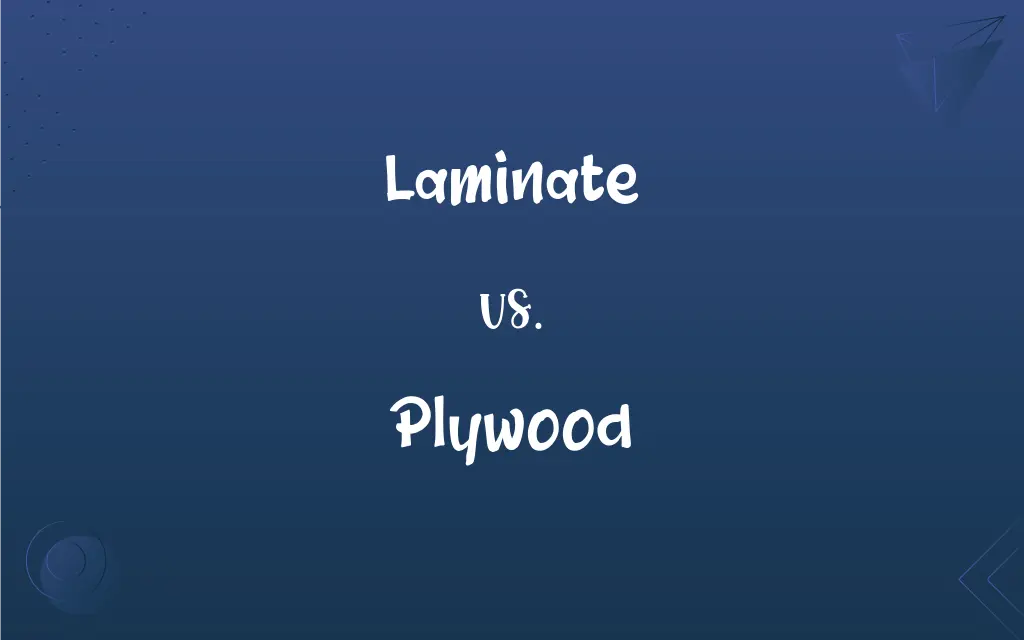Laminate vs. Plywood: What's the Difference?
Edited by Janet White || By Harlon Moss || Updated on October 18, 2023
Laminate is a synthetic material made by bonding layers, often used as a decorative surface; plywood is an engineered wood product made by gluing together thin layers of wood.

Key Differences
Laminate is primarily a decorative product created by bonding a thin layer of material to a substrate, while plywood is an engineered wood made by gluing together thin layers of wood veneer.
Laminate offers a wide range of surface finishes and is mainly used for aesthetic purposes in interiors, whereas plywood is versatile and used in structural applications.
The durability of laminate largely depends on its surface treatment and may resist scratches and stains, while plywood's strength comes from the cross-grained arrangement of its layers.
In terms of cost, laminate may vary depending on the quality and design, but it's often more affordable than high-quality hardwood plywood. However, standard plywood can be relatively inexpensive compared to decorative laminates.
When discussing maintenance, laminate surfaces are easy to clean and maintain, while plywood might need a finish to protect it from moisture or damage.
ADVERTISEMENT
Comparison Chart
Material
Synthetic material made by bonding layers
Engineered wood made by gluing layers of veneer
Primary Use
Decorative surfaces
Structural applications
Durability
Depends on surface treatment; often resists scratches
Derived from cross-grained arrangement of layers
Cost
Varies; can be more affordable than hardwood plywood
Ranges; can be inexpensive to costly
Maintenance
Easy to clean and maintain
Might need a finish for protection
ADVERTISEMENT
Laminate and Plywood Definitions
Laminate
A synthetic material created by bonding layers.
The table's surface is covered in a durable laminate.
Plywood
A material known for its cross-grained layers enhancing strength.
Plywood is often chosen for its stability in changing conditions.
Laminate
A verb meaning to overlay or coat with a protective layer.
She decided to laminate her sketches to preserve them.
Plywood
A panel often used as a base in many woodworking projects.
For his DIY project, he bought several sheets of plywood.
Laminate
A protective layer applied to documents or photos.
He decided to laminate his diploma to prevent damage.
Plywood
A strong board made of multiple veneers bonded together.
The cabinets were made of high-quality plywood.
Laminate
A compound material made by combining two or more layers.
The laminate consists of a wooden core with a plastic top layer.
Plywood
A versatile wood used in various construction and furniture projects.
She chose a birch plywood for her custom bookshelf.
Laminate
A decorative overlay for surfaces.
She chose a marble-patterned laminate for her countertop.
Plywood
An engineered wood product made by gluing thin layers of wood.
The contractor recommended using plywood for the subflooring.
Laminate
To cover with a thin sheet of material, as for preservation.
Plywood
A structural material made of layers of wood glued together, usually with the grains of adjoining layers at right angles to each other.
Laminate
To beat or compress (metal) into a thin plate or sheet.
Plywood
(uncountable) Construction material supplied in sheets, and made of three or more layers of wood veneer glued together, laid up with alternating layers having their grain perpendicular to each other.
After the hurricane there was a severe regional shortage of plywood, especially exterior plywood.
Plywood
(countable) A specific grade or type of this construction material.
We stock exterior plywoods, interior plywoods, and furniture plywoods.
Plywood
(transitive) To fit or block up with plywood.
Plywood
A laminate made of thin layers of wood
FAQs
What is laminate?
Laminate is a synthetic material made by bonding layers, often used for decorative surfaces.
Can laminate be used for structural purposes like plywood?
Laminate is mainly for decorative purposes, while plywood is used for structural applications.
Can plywood resist water?
Some types of plywood, like marine plywood, are designed to resist water.
What kind of finishes can be applied to plywood?
Plywood can be painted, stained, or varnished.
Is plywood fire-resistant?
Standard plywood isn't fire-resistant, but there are fire-resistant grades available.
Which is heavier, laminate or plywood?
Plywood is generally heavier, but it depends on the thickness and type.
Can I paint over laminate?
With proper preparation, laminate can be painted, but it's crucial to use the right primer and paint.
Can laminate mimic other materials?
Yes, laminate can be designed to mimic materials like wood, stone, or tile.
How many layers does plywood typically have?
Plywood usually has an odd number of layers, often ranging from three to seven or more.
Can I use both laminate and plywood in the same project?
Absolutely! Many projects use plywood as a base structure and laminate for decorative finishing.
laminate or plywood?
Laminate's durability depends on its surface treatment, while plywood's strength comes from its layered structure.
Can laminate be repaired if damaged?
Minor damages in laminate can be repaired, but significant damages might require replacement.
Can laminate be recycled?
Some laminates can be recycled, but it depends on their composition and local recycling facilities.
How is plywood manufactured?
Plywood is an engineered wood made by gluing together thin layers of wood veneer.
Is laminate always synthetic?
While most laminates are synthetic, there can be natural laminates made from pressed layers of material.
Can I use laminate for flooring?
Yes, there are specific laminates designed for flooring.
Is plywood environmentally friendly?
Plywood can be eco-friendly if sourced from sustainable forests and made with non-toxic glues.
What is the main difference between OSB and plywood?
OSB is made from wood strands bonded with adhesive, while plywood is made from layers of wood veneer.
Are there different grades of plywood?
Yes, plywood comes in various grades based on quality and appearance.
Is laminate resistant to scratches?
Many laminates are designed to resist scratches, but this can vary by product.
About Author
Written by
Harlon MossHarlon is a seasoned quality moderator and accomplished content writer for Difference Wiki. An alumnus of the prestigious University of California, he earned his degree in Computer Science. Leveraging his academic background, Harlon brings a meticulous and informed perspective to his work, ensuring content accuracy and excellence.
Edited by
Janet WhiteJanet White has been an esteemed writer and blogger for Difference Wiki. Holding a Master's degree in Science and Medical Journalism from the prestigious Boston University, she has consistently demonstrated her expertise and passion for her field. When she's not immersed in her work, Janet relishes her time exercising, delving into a good book, and cherishing moments with friends and family.































































